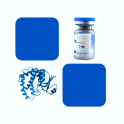
- Remove this product from my favorite's list.
- Add this product to my list of favorites.
Products
Newsletter
 |  |  |  |  |  |

Background
Hyaluronidase PH-20 also known as Sperm adhesion molecule 1 (SPAM1) and Sperm surface protein PH-20, which belongs to the glycosyl hydrolase 56 family, SPAM1 / PH-20 is expressed in testis. SPAM-1 / PH20 random hydrolysis of (1->4)-linkages between N – acetyl – beta – D – glucosamine and D-glucuronate residues in hyaluronate. SPAM-1 / PH20 involved in sperm-egg adhesion. Upon fertilization sperm must first penetrate a layer of cumulus cells that surrounds the egg before reaching the zona pellucida. The cumulus cells are embedded in a matrix containing hyaluronic acid which is formed prior to ovulation. SPAM1 aids in penetrating the layer of cumulus cells by digesting hyaluronic acid.
Source
Recombinant Human SPAM1 /PH20 Protein (rhPH20), His Tag (PH0-H5225) is expressed from human 293 cells (HEK293). It contains AA Leu 36 - Tyr 482 (Accession # P38567-1).
Predicted N-terminus: Leu 36
Molecular Characterization
This protein carries a polyhistidine tag at the C-terminus.
The protein has a calculated MW of 53.0 kDa. The protein migrates as 60-66 kDa under reducing (R) condition (SDS-PAGE) due to glycosylation.
Endotoxin
Less than 1.0 EU per μg by the LAL method.
Purity
>95% purity as determined by SDS-PAGE.
Formulation
Lyophilized from 0.22 μm filtered solution in 50 mM Tris, 100 mM NaCl, pH7.5 with trehalose as protectant.
Reconstitution
Please see Certificate of Analysis for specific instructions.
For best performance, we strongly recommend you to follow the reconstitution protocol provided in the CoA.
Storage
For long term storage, the product should be stored at lyophilized state at -20°C or lower.
Please avoid repeated freeze-thaw cycles.
This product is stable after storage at:
-20°C to -70°C for 12 months in lyophilized state;
-70°C for 12 months under sterile conditions after reconstitution.
Bioactivity
Please refer to product data sheet.
(1) "Model-Based Dose Selection of Subcutaneous Nivolumab in Patients with Advanced Solid Tumors"
Zhao, Sanghavi, Roy et al
Clin Pharmacol Ther (2023)
(2) "Extracellular Matrix Abnormalities Contribute to Cardiac Insulin Resistance and Associated Dysfunction in Diet-induced Obese Mice"
Musale, Murdoch, Banah et al
bioRxiv (2023)
(3) "A methodology of phenotyping ICU patients from EHR data: High-fidelity, personalized, and interpretable phenotypes estimation"
Wang, Stroh, Hripcsak et al
J Biomed Inform (2023) 148, 104547
Showing 1-3 of 231 papers
Welcome Login
Contact us
Follow us